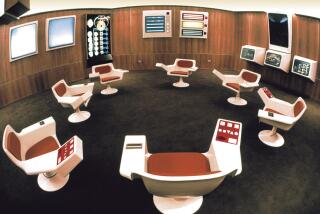‘Fifth-Generation Computer’ Makes U.S. Debut : Technology: Experts were impressed by Japan’s machine even though it doesn’t stretch the limits of artificial intelligence as much as anticipated.
- Share via
ARGONNE Ill. — In 1982, Japan announced to much fanfare its “fifth-generation computer project,” a massive, 10-year, government-sponsored campaign to create a machine that could use artificial intelligence to think, talk and respond to voice commands.
It was to be a multibillion-dollar effort, comparable to the American drive to land a man on the moon, that would pool the resources of all of Japan’s leading computer companies to leapfrog American computer technology.
On Wednesday, the fruits of the first seven years of that project were unveiled at the Argonne National Laboratory here for the first time to American scientists and reporters. After the project’s work to date, including its new computer, were shown at a conference sponsored jointly by the National Science Foundation and the Japanese government, it quickly became clear that the fifth-generation program has gone in a much different direction from what its founders anticipated.
The fifth-generation machine--about the size of two refrigerators--doesn’t talk. And the Japanese project leaders acknowledged that they have not made the kinds of advances in artificial intelligence originally anticipated.
Some American analysts argue, in fact, that the project has been a disappointment to the Japanese, and see it as proof that it is difficult for governments to make basic scientific discoveries.
“The market is generally quicker than a government in finding what works--no matter what government it is,” said Chris Mead, editor of the Phoenix-based Japan High Tech Review. “In the past, the Japanese government’s efforts were mostly designed to help Japan catch up technologically. Now, they are trying to get out front, and it’s natural they would make mistakes.”
Still, computer experts at Argonne were impressed, saying the Japanese have achieved their main objective of pushing the boundaries of computer technology.
“I think they are pretty much on track at this point with the project,” said Ewing Lusk, acting director of the advanced computing research facility at Argonne and one of the hosts of the conference at which the project was showcased.
“And remember,” he added, “this machine is only one stage in their development.”
Rather than advancing artificial intelligence, the fifth-generation project has veered off instead to take the lead in the fledgling fields of parallel processing and logic programming, computer specialists said. Simply put, parallel processing allows for problem-solving along several paths inside a computer. The new Japanese machine displayed here has 16 processors, while the typical mainframe has just one. The Japanese said they have developed a machine with 64 processors but claimed it was too heavy to bring to the United States for the demonstration.
Kazuhiro Fuchi, managing director of the fifth-generation project, said that pushing the development of parallel processing and related aspects of programming, not language comprehension, is the main goal of the project now. “From that point of view, we have made very satisfactory progress at this time,” Fuchi said.
Some American firms have already produced parallel processing computers, but Lusk said the Japanese machine does a better job of matching the parallel processing capability to sophisticated “logic programming,” allowing the computer to use higher levels of computer languages that are far easier to program.
“American machines tend to be more conventional,” said Lusk.
Ross Overbeek, a senior computer scientist at Argonne, added: “This technology is being explored worldwide, but the Japanese have pioneered some aspects of it.”
Yet Mead noted that the Japanese initially said they would develop a machine that was equipped with 1,000 parallel processors. “That’s quite a step down from 1,000 to 64,” he said.
So far, the Japanese fifth-generation consortium, known as the “New Institute for the New Generation Computing,” has quite openly shared its research with American computer scientists, Lusk said, despite trade tensions between the two nations. In fact, Wednesday’s conference was designed to foster greater cooperation between computer scientists in the two countries.
“They are completely open to us,” Lusk said. “All of their results are in the research journals now.”




